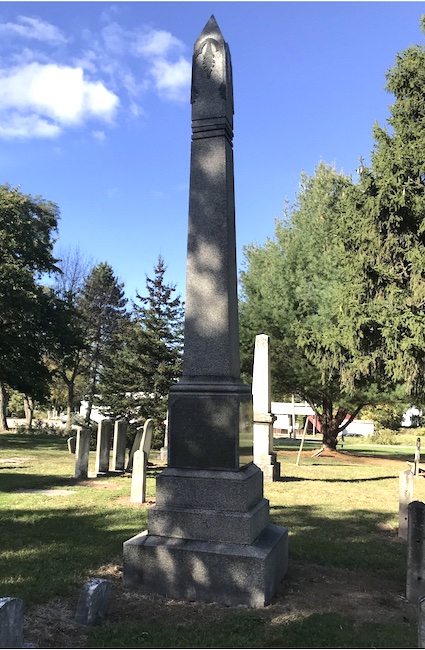Old Money’ from Ridgeway resident continues to pay 136 years after his death
By Catherine Cooper, Orleans County Historian
“Illuminating Orleans” – Vol. 3, No. 33

This obelisk which dominates Knowlesville Cemetery was erected following the death Eleazar Slater, Jr. in 1887. The first stipulation of his will directed that “any funeral charges and all debt against my estate be paid and fully discharged and a good, suitable, and proper and respectable tombstone be erected.”
KNOWLESVILLE – Eleazar Slater, Sr. and his wife, Polly, originally from Massachusetts, were early settlers in Ridgeway. They had cleared land and constructed a house by 1815. This is documented in the pioneer narrative provided by William Knowles in which he states that he stayed with them when he first arrived.
The advent of the Erie Canal proved very beneficial for that locality. William Knowles shipped the first boatload of wheat from Orleans County. He built a warehouse on the canal, freight boats stopped there. A post office was established in 1826 and the growing hamlet was named in honor of Knowles.
The Presbyterian Church in Knowlesville was formed in 1817, it was the predominant denomination in the area. The Slaters were members. Eleazar T. Slater Sr. died in 1853. Polly, his wife, died in 1863. Their son, Eleazar T. Jr., who was unmarried, died in on May 2, 1887, by which time he had accumulated a substantial sum of money.
In 1885 Eleazar Jr. sued the First National Bank of Albion to recover $5,700 worth of bonds found to be missing when Albert S. Warner absconded with the bank’s assets in 1884.
Eleazar Jr. gave a great deal of consideration to the disposal of his assets following his death and several sets of revisions and codicils were recorded. The stipulations of the will included:
Second: I give and bequeath to my sister Livera Wilders: the sum of $2,000 and one half of my household furniture, bedding, and wardrobe.
Third: I give and bequeath to my sister, Melissa Ostrander, the like sum of $2,000 and the remaining half of my furniture, bedding, and wardrobe.
Fourth: I give and bequeath to the Trustees of the Presbytery of Niagara, the sum of $50,000.
Fifth: I hereby direct the said Trustees of the Presbytery of Niagara to give the First Presbyterian Church and Society of the Town of Ridgeway the sum of $250 annually, but such sum is not to be paid until the said Society shall have paid their Pastor all of his salary for the previous years, except such sum of $250 and shall present to file with the officers of said Presbytery the receipt of such Pastor therefor. And in case the said Society fails to present such receipt from such Pastor then the said Trustees may use and exercise their own judgment regarding the payment of said $250.
Sixth: I give and bequeath the rest and residue of my estate of what nature and kind to the Board of the Home Missions of the Presbyterian Church of the United States of America.
The New York Times of May 7, 1887, reported the details of the will. The “residue” of his estate was estimated as amounting to an astounding $200,000, the equivalent of $6.5 million today. The will refers to securities, bonds, mortgages, and real estate, which presumably were the source of his wealth.
The will was soon “vigorously contested” by his heirs. It was reported in the Medina Tribune in September that progress on the issue was slow, and that eight lawyers were involved.
The Medina Tribune of October 13, 1887, noted that a compromise had been reached: The Board of Home Missions was directed to pay the heirs $22,000, Miss Emma Beckham would receive $3,000 and David Farham of Rochester would receive a small amount. The Presbyterian Church in Knowlesville would receive $5,000 in lieu of the $250 annuity. It was estimated that the aggregate of the estate after court expenses, payments and taxes would be in the region of $100,000.
Following some presbytery amalgamations, the funds later came under the control of the Presbytery of the Genesee Valley. A subsequent decision of the Surrogate Court of Orleans County directed that the Slater Fund was to be used for “the benefit of the five Presbyterian Churches located in Orleans County” (Albion, Barre Center, Holley, Lyndonville, and Medina).
The “original book Valu” of the fund was invested by the Presbytery and remarkably, the return income continues to be divided among the churches annually, 136 years following the death of Eleazar T. Slater, Jr.





































































